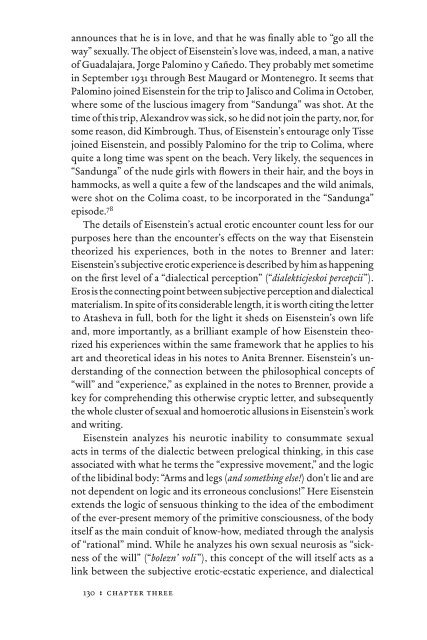In Excess: Sergei Eisentein's Mexico - Cineclub
In Excess: Sergei Eisentein's Mexico - Cineclub
In Excess: Sergei Eisentein's Mexico - Cineclub
You also want an ePaper? Increase the reach of your titles
YUMPU automatically turns print PDFs into web optimized ePapers that Google loves.
announces that he is in love, and that he was fi nally able to “go all the<br />
way” sexually. The object of Eisenstein’s love was, indeed, a man, a native<br />
of Guadalajara, Jorge Palomino y Cañedo. They probably met sometime<br />
in September 1931 through Best Maugard or Montenegro. It seems that<br />
Palomino joined Eisenstein for the trip to Jalisco and Colima in October,<br />
where some of the luscious imagery from “Sandunga” was shot. At the<br />
time of this trip, Alexandrov was sick, so he did not join the party, nor, for<br />
some reason, did Kimbrough. Thus, of Eisenstein’s entourage only Tisse<br />
joined Eisenstein, and possibly Palomino for the trip to Colima, where<br />
quite a long time was spent on the beach. Very likely, the sequences in<br />
“Sandunga” of the nude girls with fl owers in their hair, and the boys in<br />
hammocks, as well a quite a few of the landscapes and the wild animals,<br />
were shot on the Colima coast, to be incorporated in the “Sandunga”<br />
episode. 78<br />
The details of Eisenstein’s actual erotic encounter count less for our<br />
purposes here than the encounter’s effects on the way that Eisenstein<br />
theorized his experiences, both in the notes to Brenner and later:<br />
Eisenstein’s subjective erotic experience is described by him as happening<br />
on the fi rst level of a “dialectical perception” (“dialekticjeskoi percepcii ”).<br />
Eros is the connecting point between subjective perception and dialectical<br />
materialism. <strong>In</strong> spite of its considerable length, it is worth citing the letter<br />
to Atasheva in full, both for the light it sheds on Eisenstein’s own life<br />
and, more importantly, as a brilliant example of how Eisenstein theorized<br />
his experiences within the same framework that he applies to his<br />
art and theoretical ideas in his notes to Anita Brenner. Eisenstein’s understanding<br />
of the connection between the philosophical concepts of<br />
“will” and “experience,” as explained in the notes to Brenner, provide a<br />
key for comprehending this otherwise cryptic letter, and subsequently<br />
the whole cluster of sexual and homoerotic allusions in Eisenstein’s work<br />
and writing.<br />
Eisenstein analyzes his neurotic inability to consummate sexual<br />
acts in terms of the dialectic between prelogical thinking, in this case<br />
associated with what he terms the “expressive movement,” and the logic<br />
of the libidinal body: “Arms and legs (and something else!) don’t lie and are<br />
not dependent on logic and its erroneous conclusions!” Here Eisenstein<br />
extends the logic of sensuous thinking to the idea of the embodiment<br />
of the ever-present memory of the primitive consciousness, of the body<br />
itself as the main conduit of know-how, mediated through the analysis<br />
of “rational” mind. While he analyzes his own sexual neurosis as “sickness<br />
of the will” (“bolezn’ voli ”), this concept of the will itself acts as a<br />
link between the subjective erotic-ecstatic experience, and dialectical<br />
130 : chapter three


